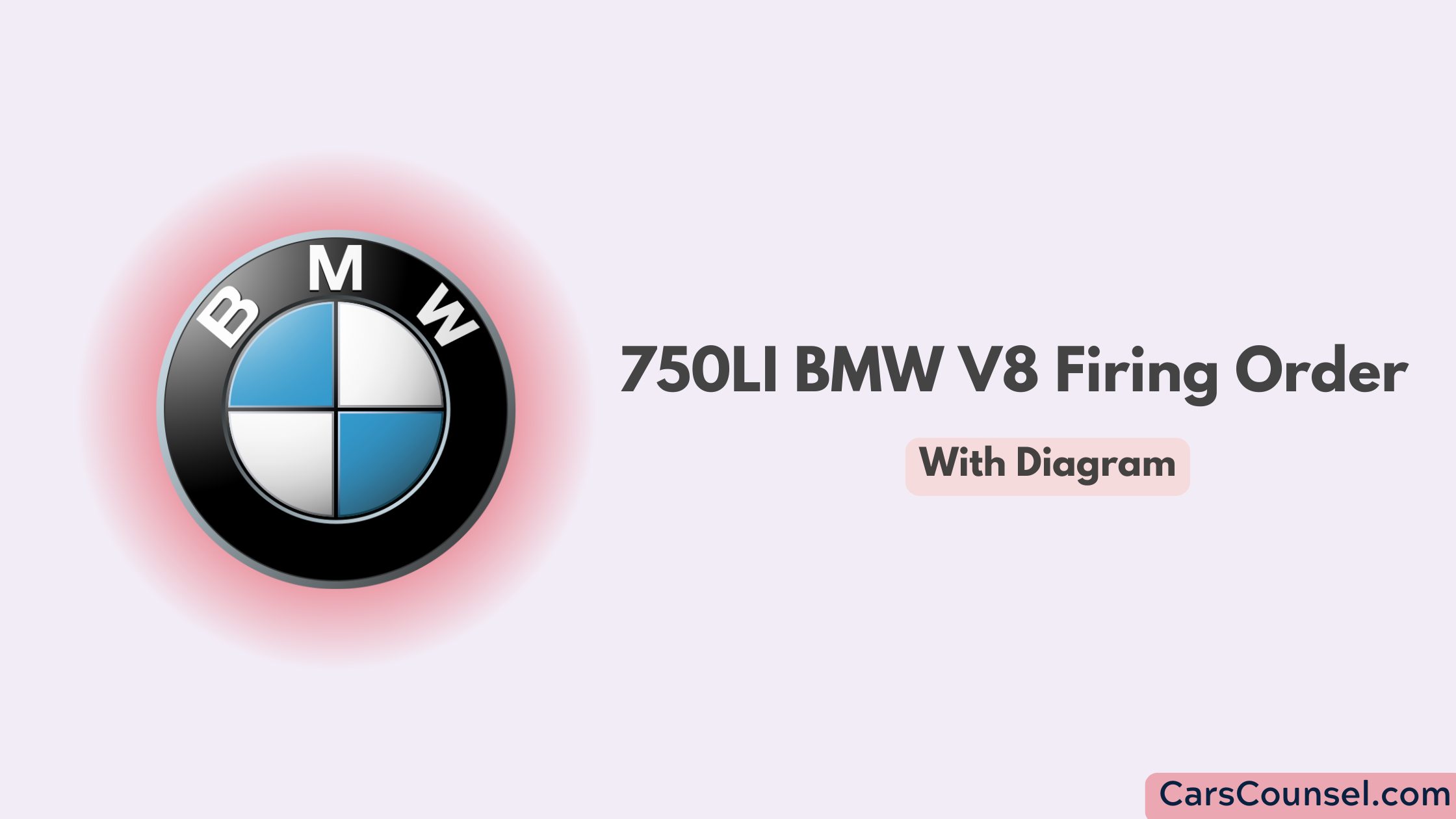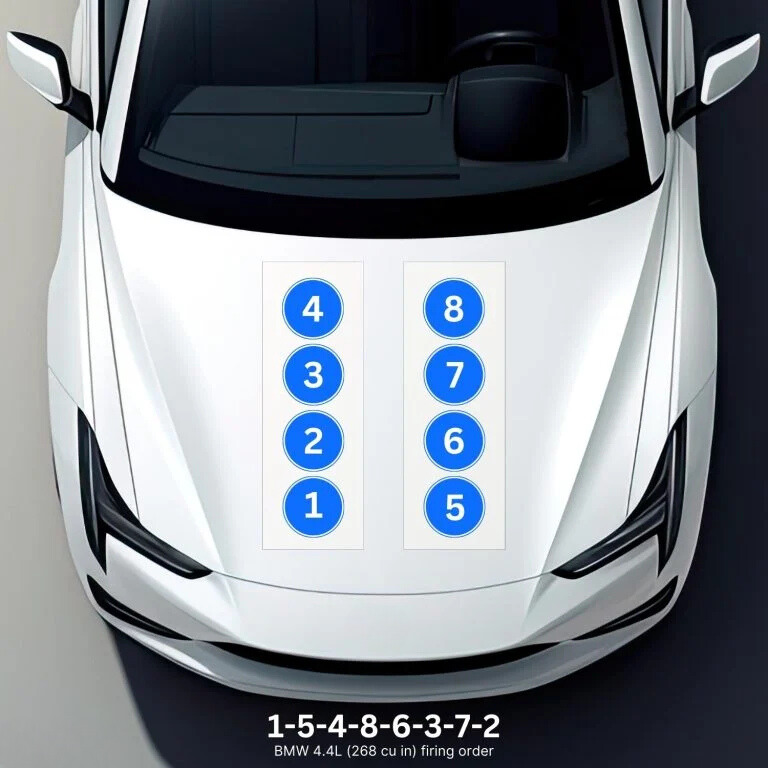The BMW 750Li, a flagship luxury sedan, is powered by a high-performance V8 engine that balances power, refinement, and efficiency. A critical component of its smooth operation is the firing order, the precise sequence in which the cylinders fire to generate power. Understanding the firing order is essential for maintenance, troubleshooting, and optimizing engine performance.
This guide explores the firing order of the BMW 750Li’s V8 engine, explains its significance, and provides insights for owners and mechanics. Whether you’re a BMW enthusiast, a professional technician, or simply curious about engine mechanics, this detailed article has you covered.

Quick Navigation
The BMW 750Li V8 Firing Order
The firing order for the BMW 750Li’s V8 engine is: 1-5-4-8-6-3-7-2

How the Firing Order Works
- Cylinder 1 Fires First: Located on Bank 1, closest to the front of the engine.
- Cylinder 5 Fires Second: Located on Bank 2, closest to the front on the passenger’s side.
- Cylinder 4 Fires Third: Located on Bank 1, fourth from the front.
- Cylinder 8 Fires Fourth: Located on Bank 2, fourth from the front.
- Cylinder 6 Fires Fifth: Located on Bank 2, third from the front.
- Cylinder 3 Fires Sixth: Located on Bank 1, third from the front.
- Cylinder 7 Fires Seventh: Located on Bank 2, second from the front.
- Cylinder 2 Fires Last: Located on Bank 1, second from the front.
This sequence alternates firing events between the two banks, ensuring smooth power delivery and reducing vibrations.
Why BMW Uses the 1-5-4-8-6-3-7-2 Firing Order
The 1-5-4-8-6-3-7-2 firing order is specifically designed to optimize the BMW 750Li V8’s performance and efficiency. Here’s why it works:
- Balanced Operation: Alternates firing between cylinders on each bank to reduce vibrations and improve stability.
- Efficient Combustion: Ensures proper spacing between combustion events for complete fuel burn.
- Consistent Torque Output: Provides steady power delivery, enhancing acceleration and drivability.
- Crankshaft Optimization: Reduces mechanical stress, improving engine longevity.
What Is a Firing Order?
The firing order is the sequence in which an engine’s cylinders ignite the air-fuel mixture. In a V8 engine, this ignition sequence is crucial for balancing the engine’s power delivery and reducing vibrations.
The firing order is determined by the engine’s design, including its crankshaft and cylinder arrangement.
Why the Firing Order Is Important
- Smooth Operation: Ensures balanced combustion, minimizing engine vibrations.
- Performance: Delivers consistent power output for smooth acceleration and operation.
- Efficiency: Promotes optimal combustion, improving fuel economy and reducing emissions.
- Durability: Distributes mechanical stress evenly across the crankshaft and internal components, prolonging engine life.
Overview of the BMW 750Li V8 Engine
The BMW 750Li is equipped with the N63 or N62 V8 engine, depending on the model year. These twin-turbocharged engines are engineered for high performance and offer a combination of power and refinement typical of BMW’s luxury vehicles.
Key Features of the BMW 750Li V8 Engine
- V8 Configuration: Eight cylinders arranged in a 90-degree “V” layout.
- Twin-Turbocharged: Enhances power output and efficiency by forcing more air into the cylinders.
- Direct Injection: Optimizes fuel delivery for better combustion and efficiency.
- Cylinder Numbering:
- Bank 1: Cylinders 1, 2, 3, 4 (on the driver’s side in U.S. models).
- Bank 2: Cylinders 5, 6, 7, 8 (on the passenger’s side).
Identifying the Firing Order
Understanding the firing order is essential for troubleshooting, tuning, and maintaining the BMW 750Li’s engine. Here’s how you can identify and verify it:
Cylinder Numbering
The cylinder layout is crucial for applying the firing order:
- Bank 1 (Driver’s Side): Cylinders 1, 2, 3, 4 (front to back).
- Bank 2 (Passenger’s Side): Cylinders 5, 6, 7, 8 (front to back).
Verifying the Firing Order
- Refer to the Owner’s Manual: The vehicle’s service manual provides detailed specifications, including the firing order.
- Inspect Ignition Components: Check spark plug wires or coil packs for proper routing.
- Use Diagnostic Tools: A timing light or an onboard diagnostic system (OBD-II scanner) can confirm the firing order.
Symptoms of an Incorrect Firing Order
If the firing order is incorrect, the engine may exhibit several performance issues that can compromise its reliability and drivability. Recognizing these symptoms can help you identify and resolve problems effectively.
Common Symptoms
- Engine Misfires: Cylinders fail to ignite properly, leading to uneven power delivery.
- Rough Idling: The engine vibrates excessively or feels unstable while idling.
- Power Loss: Reduced performance and acceleration due to disrupted combustion.
- Backfiring: Improper timing may cause combustion in the intake or exhaust manifold.
- Increased Fuel Consumption: Inefficient combustion results in higher fuel usage and emissions.
Diagnosing and Fixing Firing Order Problems
If you suspect firing order issues in your BMW 750Li, follow these steps to diagnose and resolve them:
Diagnostic Steps
- Inspect Ignition Components: Check coil packs, spark plugs, and ignition wiring for proper connection and routing.
- Verify Cylinder Timing: Use a timing light to ensure the ignition system aligns with the firing order.
- Check Compression: Perform a compression test to verify each cylinder’s functionality.
- Scan for Error Codes: Use an OBD-II scanner to identify misfire-related trouble codes.
Fixing Common Issues
- Reconnect Ignition Wires: Ensure coil packs or spark plug wires are routed to the correct cylinders according to the firing order.
- Replace Faulty Components: Install new spark plugs, ignition coils, or wiring as necessary.
- Adjust Timing: Use diagnostic tools to synchronize the ignition timing with the engine’s specifications.
Preventative Maintenance for Firing Order Reliability
Maintaining the correct firing order is essential for the long-term performance of your BMW 750Li. Follow these preventative measures:
Regular Inspections
- Check spark plugs, ignition coils, and wiring for wear, corrosion, or damage.
- Inspect the timing chain or belt for proper alignment during routine maintenance.
Replace Components as Needed
- Replace spark plugs and ignition coils at intervals recommended by BMW.
- Use OEM parts to ensure compatibility and reliability.
Verify Timing
- Periodically inspect and adjust ignition timing using diagnostic tools.
- Confirm proper timing alignment during major repairs or engine rebuilds.
FAQs About the BMW 750Li V8 Firing Order
Can I Change the Firing Order?
No, the firing order is fixed by the engine’s design and crankshaft configuration. Altering it would require significant modifications.
What Happens If the Firing Order Is Incorrect?
An incorrect firing order can cause misfires, power loss, rough operation, and potential damage to engine components.
How Can I Verify the Firing Order?
Refer to the service manual, inspect ignition wiring, and use diagnostic tools to confirm the sequence.
Is the Firing Order the Same for All BMW V8 Engines?
No, while some BMW V8 engines share similar firing orders, variations exist based on the engine series and design.
Engines with Similar Firing Orders
- BMW N63 Firing Order With Diagram
- Straight 6 Firing Order
- 1342 Firing Order
- 2011 Mini Cooper Firing Order
- 2009 Mini Cooper Firing Order
Conclusion
The 1-5-4-8-6-3-7-2 firing order is critical to the operation of the BMW 750Li V8 engine. It ensures smooth performance, balanced power delivery, and efficient combustion. Understanding and maintaining this firing order is essential for troubleshooting, tuning, and maximizing the engine’s potential.
By following proper maintenance practices, verifying ignition timing, and addressing issues promptly, you can keep your BMW 750Li running at its best. Whether you’re a DIY enthusiast or a professional mechanic, mastering the firing order is a vital step in maintaining the performance and reliability of this luxury sedan.

